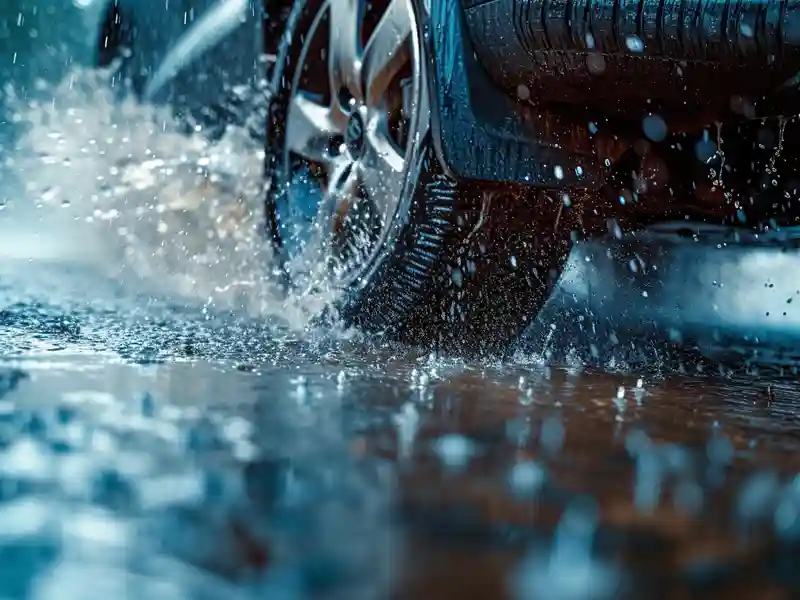Can driving into a puddle damage your brakes? We’re checking out a popular myth!
Spring storms can be violent and short-lived. Can driving into a puddle damage your brakes? A popular myth circulates among drivers. How much truth is there in it?
Braking systems are currently highly advanced systems. They consist of a series of sensors that may be damaged during excessive contact with water. What is the reality?
In the article:
Water is the enemy of modern cars
Can driving into a puddle damage your brakes?
Observing the road comes first
Heated brake discs and contact with water
Can driving into water damage your brakes? Summary.
Water is the enemy of modern cars
Every modern car that was built in the 21st century is now basically a running computer. Fiber optics and sensors are now a standard on an increasingly large scale. Safety systems responsible for emergency braking must work closely with the braking system.
In the case of vehicles that have been significantly flooded, it is very clear how many electronic systems stop working properly. The engine runs unevenly, the infotainment system does not work, or errors related to the lighting appear. However, can driving into a puddle damage the brakes, as a component consisting of a pad, disc and caliper?

Can driving into a puddle damage the brakes?
When the situation on the road forces us to drive into a puddle, there is a concern about the brakes. There are myths circulating among drivers that sudden contact with cold water can deform the brake disc.
Of course, a very hot disc can be damaged after deliberate contact with cold water in large quantities. Sudden cooling will affect the structure of the steel. However, such situations occur extremely rarely in everyday use of the car. Under standard conditions, and even in extreme driving conditions, permanent damage to the brakes by driving into a puddle is practically impossible.
Observing the road comes first
It is the duty of every driver to actively analyze the situation on the road. Looking far ahead of the car allows you to adjust your speed and direction of travel. Thanks to this, you can avoid or minimize the risk of driving into an obstacle on the roadway.
A puddle is a very uncertain obstacle on the road. If it is dry, driving into the water with one side of the vehicle can cause the wheels to skid. In addition, the water resistance will reduce speed to some extent. In addition, even if you know the route, you are not sure how deep the puddle is and what is under the water surface. Therefore, if possible, it is worth avoiding the puddle.
When driving into the water is the safest option, the circumstances are favorable to us. If there is a large amount of water on the roadway, the outside temperature is very likely to be moderate. Extreme heat excludes the presence of puddles with cold water. And as a result – even if the brake system heats up very much, there is no risk of rapid cooling.
Hot brake discs and contact with water
Driving in extreme conditions on the race track or on special stages also carries a moderate risk of damaging the brakes by driving into a puddle. Rotinger brake discs and pads designed for frequent braking from high speeds are made of durable metal alloys.
In addition, there are usually transitional conditions between hot and sunny weather and a sudden cloudburst. In addition, water in the form of rain cools the brake system. Drivers must adapt their driving style to the new circumstances. Driving in the rain reduces sudden braking to a minimum. Therefore, the average temperature of the brake pad and disc decreases. When the amount of water on the track is large enough to create puddles, all the critical points of the brake system, including the driver, will adapt to the current conditions.
Can driving into water damage the brakes? Summary.
Based on the above examples, it is easy to conclude that driving into water itself should not damage the brakes mechanically. There is a much greater probability that the electronics will fail in used cars. The sensors responsible for controlling the ABS or ESP system can be damaged by everyday use and moisture. As a result, they provide incorrect data to the control unit.
Such a development of the situation can have a negative impact on the operation of the braking system. Then, most often, the yellow ABS warning light appears on the dashboard. It informs the driver that there is a problem with the operation of this system or its derivatives. Therefore, caution is recommended.
In such a case, if we feel unsafe behind the wheel, we recommend stopping the vehicle in a safe place and assessing the efficiency of the braking system. If the ABS warning light is a cause for concern, it is reasonable to call roadside assistance and consult the fault with a professional service.
ROTINGER brakes, safety in all weather conditions. Check the offer!
Discover ROTINGER:
- brake discs – a wide range of discs for passenger cars and light commercial vehicles
- GRAPHIT LINE brake discs – a unique, patented technology for anti-corrosion protection of brake discs
- HIGH PERFORMANCE brake discs – a special line of High Carbon class discs
- BS LINE brake discs – a wide range of discs integrated with bearings for French cars
- TUNING brake discs – the widest offer on the tuning brake disc market
- brake pads – designed with safety and durability in mind
